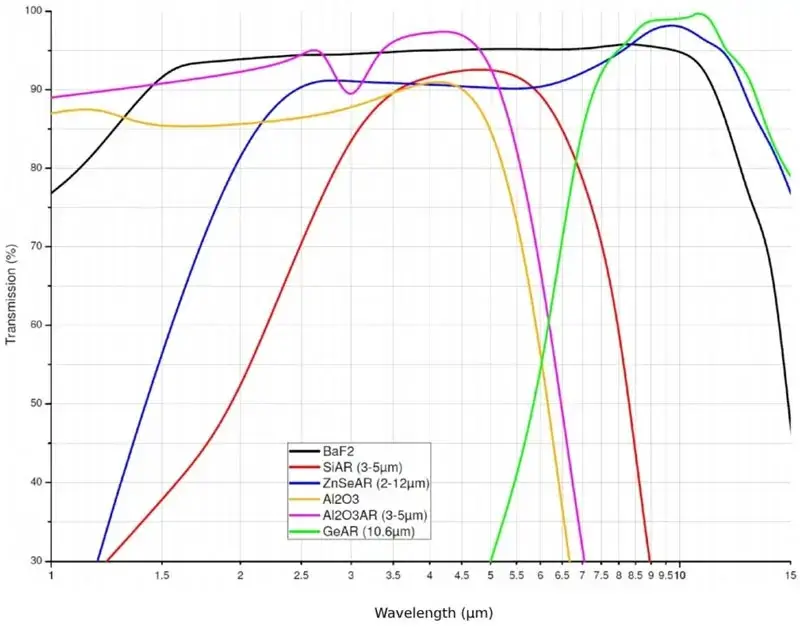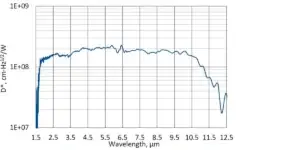Can we help you?
The knowledge base contains documentation and articles written by our experts. Here you will find all the necessary information about VIGO technologies and solutions.

Access to file
Access to this file is limited. In order to download it, please provide all the information and submit the form.
Application notes

Temperature sensor characteristics
Articles
Frequently asked questions
In this section, you can read about the most frequently asked questions and answers about Vigo Photonics products.
Select category:
What are PC detectors?

Photoconductive Devices (PC) are detectors based on the photoconductive effect. Infrared radiation generates charge carriers in the semiconductor active region decreasing its resistance. The resistance change is sensed as a voltage change by applying a constant current bias. The optimum bias current is specified in the Final Test Report and depends on the detector size, operating temperature and spectral characteristics. PC detectors in our offer comes with different spectral response. Ask our Sales Department for any details!
What are PV detectors?

Photovoltaics Devices (PV) are detectors based on the photovoltaic effect. Infrared radiation generates charge carriers in the semiconductor active region thanks to generation phenomenon. Specially prepared layers of semiconductor are constructed with electrical contacts which can enable measuring the generated electrical signal. Thus light can be measured. PV detectors comes with different spectral response. Ask our Sales Department for any details!
What is the immersion lens? How they impact measurement of IR radiation?

Optical immersion is achieved by using high refractive index microlenses in order to improve performance of the devices but may limit acceptance angle. Optical immersion is a monolithic integration of a detector element with hyperhemispherical microlens (basic configuration) that makes optical linear size of detector 11 times larger compared to its physical size. This results an improvement of D* by one order of magnitude and electric capacitance by a factor of two orders of magnitude less compared to a conventional detector of the same optical area. If you are not sure about whether to use immersion lens in your system or not, be sure to ask our Sales Department for guidelines!
What are standard TEC parameters?

| Parameter | Cooling | ||
| -2TE | -3TE | -4TE | |
| Tdet [K] | ~230 | ~210 | ~195 |
| Vmax [V] | 1.3 | 3.6 | 8.3 |
| Imax [A] | 1.2 | 0.45 | 0.5 |
| Qmax [W] | 0.36 | 0.27 | 0.28 |
| ΔTmax [K] | 92 | 114 | 125 |
What is the best preamplifier in Vigo’s offer?

The broad line of preamplifiers is specifically designed for VIGO HgCdTe or III-V detectors. Each preamplifier is optimized to work with a particular type of detector. The preamplifier ensures stable work in all conditions and the highest signal to noise ratio of the whole system. There is no such thing as the best preamplifier. Each of the preamplifiers is specialized in its own category. For example µIP preamplifier is very small, PIP preamplifier can be programmable and FIP preamplifier can be very fast. For more information about preamplifiers for your applications ask our Sales Department!
What types of windows customer can choose?

VIGO thermoelectrically cooled detectors are typically provided with:
- 3° wedged Al2O3 windows (wAl2O3)
- 3° wedged ZnSe AR coated windows (wZnSeAR)
3° wedge prevents “fringing” – interference from stray back reflections. We offer windows optimized for different spectral bands, as well. VIGO detector windows is presented in the figure below.

Windows can be anti-reflection (AR) coated on two surfaces. We can mount windows provided by the user as well as filters. For more information contact our Sales Department!
When do you bias PV detectors?

We bias our PV detectors in cases when the higher speed of the detector is needed. If a higher frequency band is required, we need to speed up the detector (by biasing). Preamplifiers for biased detectors must be AC coupled.
What temperatures can III-V materials withstand ?

There is a possibility to cool it down to liquid helium temperature. As for the opposite side, we can heat it up to 200°C what makes it convenient for some of the applications. Ask Sales Department for our brand new product based on III-V materials!
What is the lifetime of Vigo’s detectors?

Lifetime strongly depends on temperature of storage and temperature of operation. At normal temperatures lifetime exceed 5 years but many customers are using our detectors for more than 10 years in laboratory applications. Usually at field applications, mechanical wear-out of optoelectronic system is main reason for end-of-life replacements.
What is the MTBF of Vigo’s detectors?

Lifetime strongly depends on temperature of storage and temperature of operation. At normal temperatures lifetime exceed 5 years but many customers are using our detectors for more than 10 years in laboratory applications. Usually at field applications, mechanical wear-out of optoelectronic system is main reason for end-of-life replacements. £ 2
Load more
Dictionary of terms
0
A
B
C
D
E
F
G
H
I
J
K
L
M
N
O
P
Q
R
S
T
U
V
W
X
Y
Z
I
Infrared (IR) Photodetectors
Infrared photodetectors are semiconductor electro-optical devices that convert infrared radiation into an electrical signal.
in – preamplifier input current noise density
density of the current noise, given in A/sqrt(Hz), generated b y the equivalent current source connected in parallel with the preamplifier input.
InAs1-xSbx
InAs1-xSbx also known as Indium Arsenide Antimonide and InAsSb is another variable band gap alloy used for fabrication of photodetectors with tunable spectral response.
H
Hg1-xCdxTe
Known also as Mercury Cadmium Telluride (MCT), HgCdTe, (Cd,Hg)Te or MerCadTel. It is a variable band gap alloy, commonly used for fabrication of photodetectors with tunable spectral response.
High cut-off frequency fhi
A maximum frequency at which a module responsivity reaches -3dB of the peak value.
P
Physical detector area A
Active area of a detector where the incident radiation is absorbed and sensed.
Photovoltaic detectors (PV, PVM)
Photovoltaic detectors (photodiodes) are semiconductor structures with one (PV) or multiple (PVM) , homo- or heterojunctions. Absorbed photons produce charge carriers that are collected at the contacts, resulting in external photocurrent. Photodiodes have complex current voltage characteristics. The devices can operate either at flicker-free zero bias or with reverse voltage. Reverse bias voltage is frequently applied to increase responsivity, differential resistance, reduce the shot noise, improve high frequency performance and increase the dynamic range. Unfortunately, at the expense of flicker noise (1/f) in most cases. Photovoltaic detectors are more vulnerable to electrostatic discharges than photoconductors.
Photocurrent
Photocurrent is the current generated by IR radiation, which is not in thermal equilibrium with detector. For small irradiation, the photocurrent is proportional to incident radiation power P:
Iph= Ri·P
where Ri is the current responsivity.
Preamplifiers
Preamplifier is an electronic device that converts a weak electrical signal at the input into an output signal sufficient for further processing.
Power supply current Isup
Supply current consumption during correct detection module operation.
Photoconductors (PC)
Photoconductive detectors based on the photoconductive effect. Infrared radiation generates charge carriers in the semiconductor active region decreasing its resistance. The resistance change is sensed as a current change by applying a constant voltage bias. The devices are characterized by near linear current-voltage characteristics. The electric field in photoconductors is constant across the device. It equals to the ratio of bias voltage and distance between contacts E= V/L
The optimum bias voltage is specified in the final test report and depends on the detector size, operating temperature and spectral response.
Photoelectromagnetic detectors (PEM)
Photovoltaic detectors based on the photoelectromagnetic effect based on spatial separation of optically generated electrons and holes in the magnetic field. The devices do not require electrical bias and show no flicker noise (1/f). The PEM devices are typically used as fast, uncooled detectors of the long wavelength radiation.
Peak wavelength λpeak
λpeak is a wavelength of detector maximum responsivity.
Power supply voltage Vsup
Supply voltage required for correct module operation. ±20% tolerance is allowed.
Power supply input (+) and (-)
Polarity of the power supply related to the ground. Swapping supply connectors may lead to module damage.
O
Optical detector area Ao
The apparent optical area of the detector which is “seen”. It is equal to physical area of the detector active element unless an optical concentrator is used. The optical detector area can be significantly magnified in detectors supplied with optical concentrators, for eg. immersion lenses (see Optical immersion chapter).
Operating temperature T
The detector active element temperature.
Output noise
Noise voltage at preamplifier output.
Output noise
Noise voltage at detection module output.
Output impedance Rout
Equivalent impedance exhibited by its output terminals.
Output current of the built-in power supply
Maximum current that can be delivered by power supply to the preamplifier, usually +/− 100mA .
Optimum wavelength
a device is optimized for. Typically, it is longer than λpeak.
Optimal operation conditions
Constant bias voltage and current readout are typically the optimum operation conditions for the best detectivity, speed of response, linearity and long term stability.
Output noise density at specific frequency vn(f0)
Noise voltage density measured at a given frequency.
Output noise density at specific frequency vn(f0)
Noise voltage density measured at a given frequency.
Output voltage offset Voff
Constant DC component of the output voltage, present both with and without IR radiation.
D
Detector formats
Square or rectangular formats are typically used for any IR detectors. Circular geometry is sometimes used for photodiodes.
Detection module
Detection module integrates detector, preamplifier, thermoelectric cooler, and other components (e.g. detector biasing circuit, heat dissipation system, optics) in a common package. The operation of detection modules can be described in similar way as for detectors, by specifying their spectral and frequency characteristics of responsivity and detectivity.
Dark current Idark
The current that flows in a photodetector in thermal equilibrium with its surrounding.
E
Equivalent small signal detector circuit
Electric properties of some photodetectors can be described by the small signal detector circuit which consists of photocurrent source Iph=Ri‧P, detector dynamic resistance Rsh, capacitance C, and series resistance Rs. Rs is the parasitic resistance of the devices that reduce available photocurrent. Unfortunately, the simple model cannot accurately describe properties of long wavelength photodiodes operating at near room temperatures.
Equivalent small signal circuit of an IR photodetector.
Preamplifier input voltage noise density – en
The density of the voltage noise, given in V/Hz1/2, generated by the equivalent voltage noise source connected in series with the preamplifier input.
C
Current responsivity Ri
Current responsivity (A/W) is the ratio of photocurrent and power of radiation. The current responsivity is typically measured for monochromatic radiation (the spectral current responsivity) and blackbody radiation (the blackbody current responsivity). The responsivity typically remains constant for weak radiation and tends to decrease with more strong radiation.
Cut-on wavelength λcut−on
λcut-on is the shorter wavelength at which a detector responsivity reaches 10% of the peak value.
Cooler current Imax
Supply current used in measured detector. Stated in Final Test Report (supplied with each VIGO device).

Current responsivity-length product Ri·L
The current responsivity of unbiased PEM, PVM and biased (with constant electric field E) PC detectors is proportional to the reciprocal length. Therefore, the current responsivity Ri·L is used to compare devices of various formats. Another normalized current responsivity, Ri·L/E, is used to compare responsivity of photoconductive devices of various format, and operating with different electric fields.
Cut-off wavelength λcut−off
λcut-off (50%) is the longer wavelength at which a detector responsivity reaches 50% of the peak value.
M
Maximum bias voltage Vmax
The maximum voltage that can be applied to a photoconductor or photovoltaic detector without a risk of its damage.
Maximum heat pumping capacity Qmax
Qmax rated at ΔT=0 , at other ΔT cooling capacity should be estimated as
Maximum TEC voltage Vmax
TEC voltage drop at ΔTmax.
Maximum thermoelectric cooler controller output voltage VTEC
Maximum voltage that is provided by the controller
Maximum temperature difference ΔTmax
ΔTmax rated at Q=0, at other Q the ΔT should be estimated as
Maximum cooler current Imax
Supply current giving the highest temperature difference (ΔTmax) at the specified conditions stated in Final Test Report (supplied with each VIGO device).
Maximum thermoelectric cooler controller output current ITEC
Maximum current that is provided by the controller .
Maximum voltage across thermoelectric cooler element
Maximum voltage for thermoelectric cooler supplying.
B
Background generated current
The photocurrent generated by thermal radiation emitted by detector surrounding
N
Noise current In
Root mean square noise current
Normalized detectivity D*
The signal-to-noise ratio (SNR) at a detector output, normalized to 1W radiant power, a 1cm2 detector optical area and a 1Hz bandwidth. D* is expressed in cm·Hz1/2/W units.
Noise 1/f corner frequency fc
Frequency, at which the low frequency noise equals to the white noise (e.g. the Johnson or shot noise) so the flicker noise dominates at f < fc.
Noise current density in
Noise measurement frequency f0
Frequency at which output voltage noise density is measured selectively.
F
Flicker noise
Flicker noise or 1/f noise is a frequency dependent noise. Its power is typically proportional to 1/f.
F-number F/#
F/# is ratio of the focal length to diameter of entrance pupil. For lenses is the ratio of focal length to diameter of lens.
Field of view FOV
Angular field of view is the maximum cone angle at which incoming radiation can be captured by a detector. Radiation coming from a larger angle will not reach the detector.
Frequency response
Dependence of voltage responsivity on frequency.
S
Spectral responsivity and spectral detectivity
Dependence of responsivity and detectivity on wavelength
Series resistance of the connecting cable
Material parameter – resistance of the supply cable. It depends on cable length.
Sheet resistance Rsq
It is used to compare the resistances of rectangular photoconductive, PEM and PVM devices with different aspect ratios. It equals to the ratio of product of detector resistance and distance between contacts to detector width.
Settling time of the set detector temperature
The time taken by the cooling system to reach appropriate temperature of the detector.
R
Resistance – area product Rd·A
Area-normalized dynamic resistance, Rd·A, of photodiodes that is used to compare photodiodes of different format, in which dynamic resistance decreases proportionally to the detector active area.
Ripple of output current
Unwanted residual periodic variation of the DC (direct current) output of a power supply (or other device) which has been derived from an AC (alternating current) source. This ripple is due to incomplete suppression of the rectified DC waveform within the power supply.
L
Linearity range
The linearity range of detector operation is the radiation power range for which the sensitivity remains constant. It is limited by the drop in responsitivity (typically specified for 10% drop).
Low cut-off frequency flo
A minimum frequency at which a AC coupled module responsivity reaches -3dB of the peak value or 0 Hz for DC coupling devices.
Low cut-off frequency flo
A minimum frequency at which a preamplifier gain reaches -3dB of the peak value or 0 for DC coupling devices.
Load resistance RL
The expected resistance of the device connected to the detection module’s output. The parameters provided in the detection module test sheet are valid if the load resistance equals RL. Usually RL=1MOhm, for modules operating below 20 MHz, and 50 Ohm for devices operating over 20 MHz.
T
Time constant τ
Typically, detector time response can be described by the one pole filter characteristics. Time constant is the time it takes detector to reach of the initial signal value. The time constant is related to the 3dB high cut-off frequency fhi:
Time constant for one pole filter is related to 10 – 90% rise time tr:
tr=2.2⋅τ
Transimpedance amplifier
Transimpedance amplifier (briefly called TIA), converts the current signal to the voltage. The transimpedance amplifier presents a low impedance to the photodetector and isolates it from the output. TIA low input impedance provides stable biasing conditions for the detector which helps to achieve maximum linearity and bandwidth.
Temperature sensor inputs
Temperature sensor pins – might be connected with any polarity.
Thermoelectric coolers (TEC)
Operation of thermoelectric coolers is based on Peltier effect. Two-, three- and four-stage thermoelectric coolers are available. TEC is biased with DC current supply. The parameters of the TEC depend on temperature of the hot side of cooler. It is typically specified for 300 K.
Transimpedance Ki
Output voltage to input current conversion factor (ratio).
Thermoelectric cooler supply input (+) and (-)
Supply polarity for the TEC. Those pins are floating, which means they are not connected to the GND.
V
Voltage swing Vout
The maximum and minimum voltages where preamplifier works in linear range.
Voltage responsivity Rv
The output voltage divided by optical power incident on the detector. For spectral measurements it can be expressed as
Rv(λ)=Ri(λ)·Ki
A
Average output voltage noise density
0
1/f noise corner frequency fc
Frequency, at which the low frequency noise equals to the white noise (e.g. the Johnson or shot noise) so the flicker noise dominates at f < fc.























